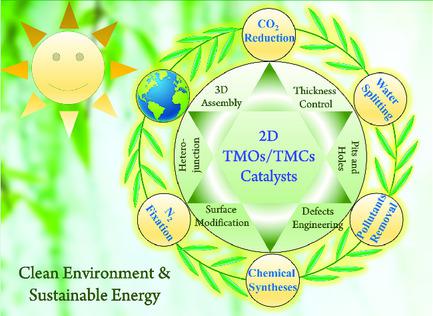Our official English website, www.x-mol.net, welcomes your feedback! (Note: you will need to create a separate account there.)
Two-Dimensional Transition Metal Oxides and Chalcogenides for Advanced Photocatalysis: Progress, Challenges, and Opportunities
Solar RRL ( IF 6.0 ) Pub Date : 2020-09-23 , DOI: 10.1002/solr.202000403 Guoxin Zhuang 1 , Jiawei Yan 1 , Yonglin Wen 1 , Zanyong Zhuang 1, 2 , Yan Yu 1, 2
Solar RRL ( IF 6.0 ) Pub Date : 2020-09-23 , DOI: 10.1002/solr.202000403 Guoxin Zhuang 1 , Jiawei Yan 1 , Yonglin Wen 1 , Zanyong Zhuang 1, 2 , Yan Yu 1, 2
Affiliation

|
Sunlight-driven catalytic reactions are appealing for resolving energy and environmental problems. Transition metal oxides (TMOs) and chalcogenides (TMCs) comprise one of the most popular categories of photocatalysts, thanks to their high stability, low cost, Earth abundance, and outstanding catalytic activity. Downsizing TMOs and TMCs to 2D materials offers additional opportunities to finely tune their surface, electronic, and catalytic properties. However, 2D TMOs and TMCs fall into a less mature field than other well-established 2D materials. Less is known about their “form-to-function” relationship, and mechanisms for their synthesis await more research. Herein, the progress toward the rational design of layered and nonlayered 2D TMOs and TMCs is summarized, as well as principles to engineer their nanosheets (NSs) into 3D architectures for practical application. The formation mechanisms and crystal growth models of these 2D materials are included. The key factors that determine the electronic, surface structures, and catalytic properties of 2D TMOs and TMCs are examined in particular, which are key considerations in tuning their performance in light absorption, charge carrier transfer/separation, molecule capture and activation, etc. Finally, the present challenges and future research directions in this promising field are illustrated.
中文翻译:

用于高级光催化的二维过渡金属氧化物和硫属化物:进展、挑战和机遇
阳光驱动的催化反应对解决能源和环境问题具有吸引力。过渡金属氧化物 (TMO) 和硫属化物 (TMC) 是最受欢迎的光催化剂类别之一,这要归功于它们的高稳定性、低成本、地球丰度和出色的催化活性。将 TMO 和 TMC 缩小为 2D 材料提供了额外的机会来微调它们的表面、电子和催化特性。然而,与其他成熟的 2D 材料相比,2D TMO 和 TMC 属于一个不太成熟的领域。关于它们的“形式到功能”的关系知之甚少,它们的合成机制有待更多研究。在此,总结了分层和非分层二维 TMO 和 TMC 合理设计的进展,以及将纳米片 (NS) 设计成 3D 架构以用于实际应用的原理。包括这些二维材料的形成机制和晶体生长模型。特别研究了决定 2D TMO 和 TMC 的电子、表面结构和催化性能的关键因素,这是调整其在光吸收、载流子转移/分离、分子捕获和活化等方面的性能的关键考虑因素。 最后,说明了这个有前途的领域目前的挑战和未来的研究方向。
更新日期:2020-09-23
中文翻译:

用于高级光催化的二维过渡金属氧化物和硫属化物:进展、挑战和机遇
阳光驱动的催化反应对解决能源和环境问题具有吸引力。过渡金属氧化物 (TMO) 和硫属化物 (TMC) 是最受欢迎的光催化剂类别之一,这要归功于它们的高稳定性、低成本、地球丰度和出色的催化活性。将 TMO 和 TMC 缩小为 2D 材料提供了额外的机会来微调它们的表面、电子和催化特性。然而,与其他成熟的 2D 材料相比,2D TMO 和 TMC 属于一个不太成熟的领域。关于它们的“形式到功能”的关系知之甚少,它们的合成机制有待更多研究。在此,总结了分层和非分层二维 TMO 和 TMC 合理设计的进展,以及将纳米片 (NS) 设计成 3D 架构以用于实际应用的原理。包括这些二维材料的形成机制和晶体生长模型。特别研究了决定 2D TMO 和 TMC 的电子、表面结构和催化性能的关键因素,这是调整其在光吸收、载流子转移/分离、分子捕获和活化等方面的性能的关键考虑因素。 最后,说明了这个有前途的领域目前的挑战和未来的研究方向。










































 京公网安备 11010802027423号
京公网安备 11010802027423号